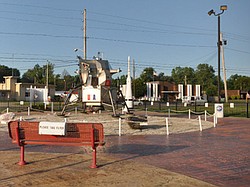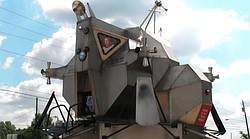

Sunday, July 19, 2009

A panorama to view the Lunar Lander replica on Parkman Road in Warren, July 13, 2009.

YSU Astronomy Professor Dr. Patrick Durrell reflects on the lunar landing of 40 years ago.
Dr. Patrick Durrell, YSU Professor of Astronomy, stands near replica of Lunar Lander in Warren.

A panorama to view the Lunar Lander replica on Parkman Road in Warren, July 13, 2009.
Warren exhibit honors Ohioan Neil Armstrong’s walk on the moon in 1969.
By JON MOFFETT
Vindicator Staff Writer
One small step four decades ago revolutionized possibilities for humankind.
Monday marks the 40th anniversary of the giant leap made by Neil Armstrong during the Apollo 11 moon mission. And though the moon is more than a quarter of a million miles from Earth, Armstrong and his heroic adventure have ties much closer to home.
A replica of the Apollo 11 landing site featuring the LEM, the lunar excursion module, can be found at Parkman Road Northwest nestled between a McDonald’s restaurant and a vacant lot. Behind the site is a plaza with Kmart and other businesses. Potholes in the street resemble the lunar surface. A black metal fence separates the two worlds.
A sign there reads: “On July 26, 1936, at the age of six, Neil Armstrong took his ‘first flight’ in a Ford Tri-motor airplane from the Warren Airways which was located on this exact site. This sparked his love of aviation.”
Armstrong was born in Wapakoneta, Ohio, and lived in Warren for a time.
“Neil would always bug his father about wanting to take a ride on an airplane,” said Pete Perich, who said he is a friend of Armstrong’s. “And that day in 1936 was the first time he had ever been on an airplane, so when he got home, his mother said she knew he and his father were up to no good.”
Perich, 87, of Warren, coordinated the site’s planning and construction. He designed the exhibit to be a tribute to Armstrong and his ties to the Mahoning Valley.
The process wasn’t easy or cheap, Perich said. He funded the project with money out of his own pocket and from a few sponsors he had convinced. He credited his family for believing in him and in an idea he almost gave up.
He obtained the original blueprints for the lunar module from NASA, and the exhibit features a half-scale replica, he said.
Perich said if he had to quantify the project in dollars, including man hours, he invested about $800,000 into the exhibit. But the return on the investment is much more important to Perich than the cost: He hopes future generations will appreciate how history can be found so close to home.
“This is what I wanted for the kids,” he said. “Neil dreamed of being a pilot all the time. That’s what it’s all about, having a dream. Kids need to have a dream.”
The crew of Apollo 11 proved dreams can come true by achieving President John F. Kennedy’s goal of landing on the moon before the decade was over. Armstrong, commander of the mission, Edwin “Buzz” Aldrin and Michael Collins blasted off from the Kennedy Space Center on Wednesday, July 16, 1969. Armstrong made history by stepping foot on the moon four days later. Aldrin followed while Collins remained in orbit aboard the command module.
And though the kids Perich hopes to inspire weren’t around for the landing, a local expert expects Apollo’s magnitude to live on.
“It’s an incredible technological achievement,” said Dr. Patrick Durrell, assistant professor of astronomy at Youngstown State University. “Humankind has always had an inkling to explore, and to be able to set foot on another world is quite an event.”
Durrell, who was 2 at the time, said even those who didn’t watch the event live can relate to it as a historic event. He visited the Warren lunar module exhibit for the first time last week.
“It’s really quite something,” he said as he walked along the brick pathway.
“People always say, ‘If we can put a man on the moon we can do anything,’ So you wonder: How do we top this?” Durrell said. “No one else is ever going to be the first person on the moon. People are talking about going back to the moon, but Neil Armstrong being the first is awe-inspiring.”
Warren Mayor Michael O’Brien, who was 14 at the time, said he remembered sitting in front of a black-and-white TV with his family.
“I remember watching the landing live on TV and then going outside and looking at the moon, just visualizing how it was possible,” he said. “To not only orbit the moon, but to get out and walk on it is heroic. It took a lot of guts.”
O’Brien said Warren is proud to house the exhibit, which he hopes educates future generations as well. He said there is federal grant money secured to expand the site and add parking. Perich said he hopes the state will dedicate the exhibit as an historical site. He hopes schools and churches will take advantage of the site and use it to inspire the next generation.
“We have some kids today who have no focus, no goals and no dedication. But if they have dreams, they may be pilots, or engineers or who knows,” Perich said. “We may have a dozen astronauts come out of it.”
Valley residents shared their memories of the event with The Vindicator.
“It’s one of those instances where I can tell you exactly where I was and what I was doing,” said Bruce Sherman, 61, of Boardman. “I’ll never forget Apollo 11 and the Kennedy assassination.”
Sherman said he remembered watching a Kenley Players’ performance at W.D. Packard Music Hall in Warren, which was interrupted to announce the moon landing. He said once the show ended, people “flocked out” of the auditorium to their televisions.
“We were home like that,” he said, snapping his finger.
Ronald Cornell Faniro, 57, of Youngstown, said he remembered the day “like it was yesterday.
“I was sitting on the sofa with my high-school sweetheart,” he said, calling the lunar landing “one of the greatest scientific achievements, surely of my lifetime.”
Faniro, who also was present for the Kent State University shooting in 1970, agreed with Sherman on historical significance.
“There was a tremendous amount of competition with the Soviet Union during the space race,” he said. “It was viewed as a battle to the moon, and [Kennedy] said he’d get there.”
Durrell said Armstrong’s legacy will be one of both historic and heroic proportions.
“I think it’s very important to keep these events in mind,” he said. “When people say it colloquially, it reminds them of what you can do. When you put your mind to it, there is no limit to what you can do ... If we can land on the moon, what else can we do?”
jmoffett@vindy.com
SEE ALSO: Aldrin helps mark his own milestone.